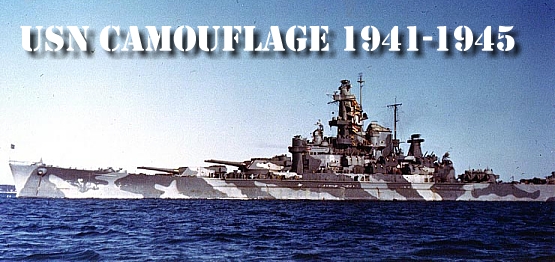The
Development of Naval Camouflage 1914 – 1945
Part II: United States Navy – World War I
By Alan Raven
(Article
reprinted courtesy of Plastic Ship
Modeler Magazine issue #96/4)
Alpha Blue and White would be
the colors used for the northern passage, and Gamma Blue and White
for those on the southern route. Alpha
Blue and White would blend to form Omega Gray, while Gamma Blue and White would
blend to give Psi-Gray.
In order to test Jones’ ideas
a procured 165’ steam yacht, the U.S.S. GEM was painted in Omega Gray overall on the port side, while the starboard side had
perspective distortiojn bands of Alpha Blue and White.
Many observations were made of the two schemes at sea and on Lake ntario.
Under favorable conditions the GEM was invisible down to 300 yards.
The Jones system was considered
so successful that in March 1918 the Submarine Defense Association published
the following statement for merchant ship owners:
“We can state to our ship owners as of authority the following: The
least visibility of ships on the most occasions at ranges of 5000 yards in the
waters south of Latitude 45 degrees North and in the Mediterranean is secured by
Psi-Gray. In the chief danger
regions – the North Atlantic, English Channel, North and Irish Seas – the
color for least visibility is Omega-Gray. For
the greatest deception of the Submarine Captain, within the 5000 yard range,
ships should use the stripes, patterns and lines of Alpha Blue and Beta White
which melt into Psi-Gray: the colors that best suit the longitudes, the
latitudes and the weather where the vessels voyage”.
DAZZLE CAMOUFLAGE
Very soon after the above
statement was published, Norman Wilkinson, the inventor of Dazzle camouflage,
arrived in the United States in order to promote his ideas.
Dazzle camouflage had been adopted on a widespread basis throughout the
British Merchant Fleet and by many warships of the patrol and escort type.
So successful was he in convincing the
U.S. authorities of the value of Dazzle camouflage that they immediately
authorized all ocean going merchant ships to be so painted.
The camouflage section of the Shipping Board prepared a total of 495
Dazzle designs, of these 302 were applied to merchant ships, 193 were applied to
warships from cruisers down to patrol vessels and minesweepers.
In addition to the above, 36 U.S. destroyers serving in British waters
were painted in Dazzle patterns prepared by Norman Wilkinson.
By the middle of 1918 virtually
all of the revious systems; Brush, Toch, etc., had disappeared, replaced by the
British Dazzle type. During the
course of the war, over 1200 U.S.vessels were given Dazzle patterns, and only
one percent were lost to torpedo attack.
In 1920 the Bureau of
Construction and Repair gave the following opinion as to the value of Dazzle
camouflage: “It is considered
beyond doubt, however, that camouflage painting was of distinct value,
particularly in the case of large and fast vessels, which might be saved from
disaster by the momentary confusion of the attacking submarine commander”.
This was in direct contrast to
British official opinion, which was ambivalent at best. (See Part 1).
ANTI-RANGEFINDING CAMOUFLAGE
The Navy, not unexpectedly, was
interested in using camouflage to produce an effect that would confuse enemy
rangefinders. To this end a series
of designs were drawn up by Mr. Watson, the master painter at Norfolk Navy Yard.
The initial design was painted onto the U.S.S. MARGARET, a patrol vessel,
in late September 1917. The design
consisted of large irregular sawtooth panels running the length of the ship. Observations at sea were made in September and October, but
surprisingly, all of the reports commented on the visibility aspect only!
None were made on any confusion as to ranging.
Called the “Watson Norfolk
System”, further designs were prepared and tried out on battleships with a
small degree of success. The
British had already tried anti-rangefinding camouflage in the form of canvas
baffles and shapes hung from funnels and masts.
None of these ideas would have fooled the Germans as they employed stereo
rangefinders, as against to co0incidence type used by the American and British
navies.
Submarines also came in or some
experimental paint schemes, designed to reduce visibility by means of near
vertical stripes. Tests were
inconclusive and it was believed that the best panting for concealment,
especially from the air, would be to paint the horizontal surfaces black, with
the vertical surfaces light gray, an idea that was subsequently adopted.
The range of colors used by the
American Navy in 1917-1918 was extensive, ranging from black to white and just
about everything in-between. Because
of the lack of knowledge as to what ranges of colors were suitable for use on
ships at sea, there were colors used that were eschewed in World War II, such as
reds, violets, and yellows. The
total number of colors employed is unknown, but when coupled with the large
number used by the British in their “Dazzle” designs, the author believes
that well over two hundred were used on ships.
Page 5
[ Back Page ] [ Home ] [ Table of Contents ] [ Next Page ]
| 